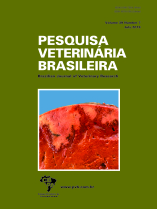 |
|
|
|
Year 2019 - Volume 39, Number 7
|

|
Canine lymphomas diagnosed in the southern Brazil from 2000 to 2017: epidemiology and immunophenotype, 39(7):492-498
|
ABSTRACT.- Coelho A.C.B., Echenique J.V.Z., Lemos B.S., Estima-Silva P., Sallis E.S.V., Raffi M.B. & Schild A.L. 2019. Canine lymphomas diagnosed in the southern Brazil from 2000 to 2017: epidemiology and immunophenotype. [Linfomas caninos diagnosticados na região Sul do Rio Grande do Sul de 2000 a 2017: epidemiologia e imunofenótipo.] Pesquisa Veterinária Brasileira 39(7):492-498. Laboratório Regional de Diagnóstico, Faculdade de Veterinária, Universidade Federal de Pelotas, Campus Universitário s/n, Centro, Pelotas, RS 96010-900, Brazil.
E-mail: alschild@terra.com.br
Lymphoma is a neoplasm that originates from solid hematopoietic tissues and is one of the most common tumors in dogs. The goal of the present study was to perform a retrospective study of canine lymphomas diagnosed at the “Laboratório Regional de Diagnóstico”, at the “Faculdade de Veterinária” of the “Universidade Federal de Pelotas” (LRD-UFPel) from 2000 to 2017, to determine the epidemiology and anatomical distribution, and to evaluate the histopathological and immunohistochemical aspects of each case according to the adapted Kiel classification. The protocols for necropsies and biopsies in the laboratory were reviewed. Lymphoma was diagnosed in 77 dogs. Approximately 37.7% (29/77) of affected dogs had no defined breed, while dogs with defined breeds accounted for 58.4% (45/77) of the diagnoses. The occurrence in males (40/77) was slightly higher than that in females (36/77), and the mean age was 8.1 years (1.4-17 years). The most affected age group was between six and 10 years of age with 31 cases (40.2%). Regarding the anatomical classification, the multicentric form was the most prevalent, accounting for 71.4% (55/77) of the diagnoses. In 40 cases that immunophenotyping was performed, B-cell lymphomas represented 62.5% of the diagnoses (25/40), while T-cell lymphomas corresponded to 37.5% of the diagnoses (15/40). The degree of malignancy according to the modified Kiel classification was low in 35% of lymphomas (14/40) and high in 65% of cases (26/40). The multicentric form was more frequent in the region of influence of the LRD-UFPel. Identification of the immunophenotype can improve the quality of life and survival in affected dogs since it allows the most appropriate treatment for each patient. |
| |
|
|
| |
|
 |